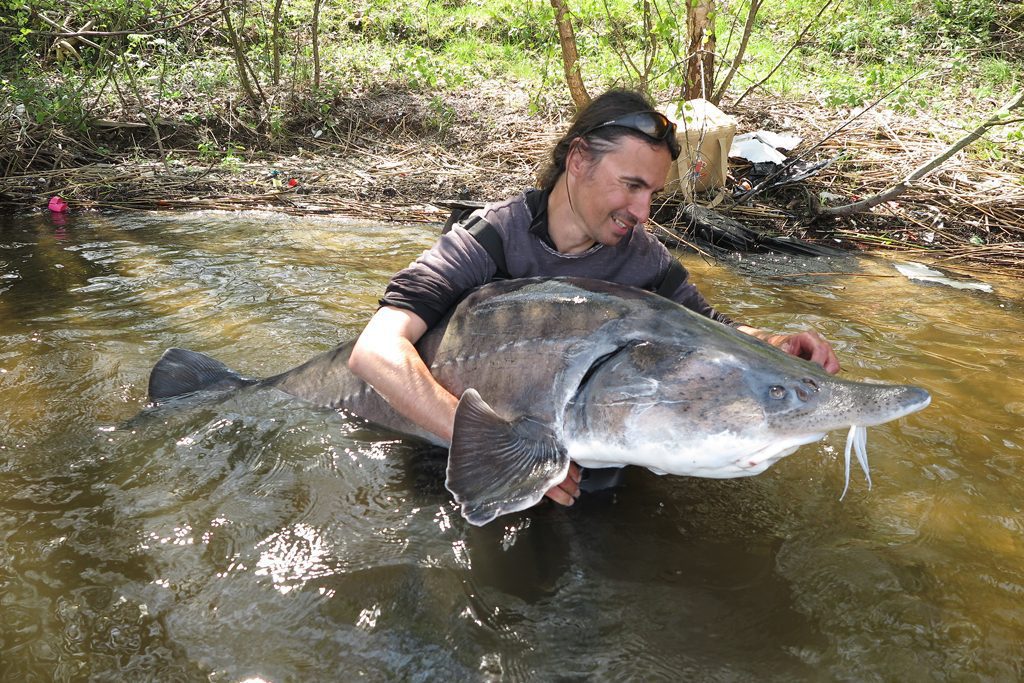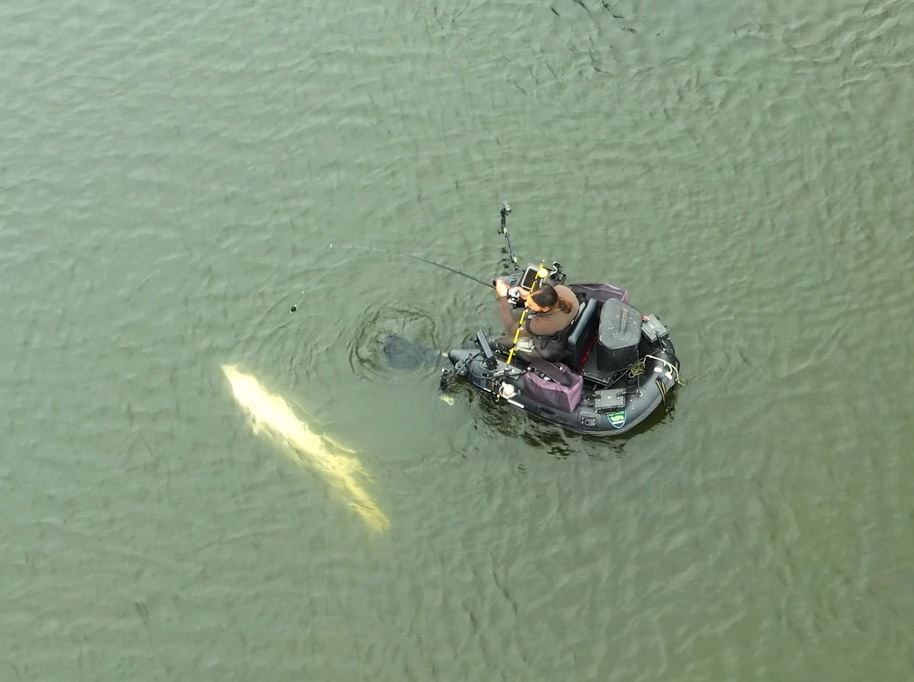Sturgeons trolling from the bellyboat - Dutch fish over 2 metres in length

Thomas Sintobin says it well: "Closed time does crazy things to people." So did Thomas. He has already made his mark in catfish fishing and it was time for a new challenge. As well as fish that grow to over 2 metres, the beluga sturgeon
By Thomas Sintobin
In 1922, a freshwater fish so heavy that 10 strong men could not lift it was caught in the Volga delta. It was a Huso huso - or beluga door weighing, hold on, 1224 kilograms at a length of more than 7 metres (click HERE) And that, according to scientists, is not even the maximum size this prehistoric-looking species can reach, although there is no photographic evidence of even larger specimens. The chances of it ever reaching that size are slim. Indeed, these giants are threatened with extinction because their eggs are considered a delicacy: caviar

The black gold of the beluga sturgeon.
Caviar from farmed belugas costs a fortune - 250 euros for 50 grams - and it is also said to be extremely delicious: "A taste explosion takes place in the mouth when you take in the Beluga caviar. With flavour notes such as the saltiness of salty, a little cream and a hint of nuts, Beluga caviar will make you never want to try another kind of caviar," according to the website of a trader. Caviar from wild fish is now banned from trade, but is thriving on the black market.

A 220cm beluga sturgeon caught in Enschede last year.
Wild sturgeons spend much of their lives in the sea, but migrate up river to spawn. Like salmon and sea trout, they are therefore resistant to both fresh and salt water, and this characteristic allows them to thrive in lakes as well.
Breeding belugas
So although wild sturgeon are doing anything but well, there are more farmed belugas today than ever before. You can just buy them in pond shops, and owners of quite a few paywaters across Europe have released this imaginative primeval fish to lure anglers from far and wide.

How big they will be able to grow in ponds and lakes, no one knows. Indeed, none of us will ever know, because sturgeons can grow ridiculously old, possibly as old as 150 years. Since a 2-metre sturgeon is around 20 years old, this means that these fish can continue to grow for at least another century, and we humans simply cannot manage that.
A new challenge
The closed season for predatory fishing does crazy things to people. I usually spend a large part of those two months fishing for catfish on the big rivers, but this year, for one reason or another, I don't feel like it. The fact that most of the swims where I could do my thing nice and quiet until last year are really totally overrun by brand-new catfish anglers nowadays, of course, plays some part, because I am extremely fond of peace and quiet.

2-metre-plus catfish? Check! Looking for another fish in the Netherlands that can get that big!
Besides, I was also just ready for something else, after all those years of hunting the King of Slime intensively from my bellyboat (click HERE). One evening I suddenly got the idea that I would like to catch a big beluga sturgeon from that floating sofa. I also knew exactly where I was going to try it: a 50-hectare sand excavation in Enschede, which has been operated as a paywater for a year now. I know a lot of readers have absolutely nothing to do with paywaters, but this water is somewhat different from other ponds. Namely, the lake is extremely nutrient-rich, possibly due to the continued extraction of sand and the presence of beautiful reed beds and shallows. Long before sturgeon, catfish, loach and striped bass were released, an extremely good natural stock of perch, pike and pike lived here.
A bizarrely large 227-cm catfish was caught at Fishing Adventure in Enschede in 2019. See video below.
Two years ago, before it was officially opened, I had been there once for a report by the Belgian TV channel Rural TV, and back then I had managed to catch a beluga of about 165 cm on a perch rod and a shad. The drill took forever and we only got the fish under control by jumping on top of it with two men: it provided one of the most exciting moments of my fishing life, and there was a cameraman there (click HERE for the video).
Here we go
One phone call to the water's owner, Bart De Vries, later, I knew that my bellyboat and I were welcome. A fishing buddy who had just bought his first bellyboat was willing to come along, and a few days later we were silently gliding above the mysterious depths of the lake, armed with a sturdy catfish rod, a reel and a couple of boxes of Canadian dewfish.

Yes I see interesting signals, but whether I 'may' sail above them with my bellyboat....
So in fact I had brought my usual catfish gear, hoping it would also suffice for this species. I had no doubts about the rod: it is a hand-finished fibreglass rod (with a lock of my youngest daughter's hair incorporated in the winding of the first eye), hand-finished by my fishing partner Michel, and indestructible. But would my reel hold up, and above all, would barely 130 metres of line suffice?

Whether my gear would hold up would reveal itself soon enough...
On my depth gauge I soon see the necessary clouds of baitfish, just near them very large symbols. One, by my estimation, is quite a catfish, but although I let the worms wriggle right above its mouth, it does not lose control. The other symbols I see swimming here and there are obviously sturgeons. Which species it is, I can't say then; white sturgeons, diamond sturgeons, sterlets, Russian sturgeons and, of course, belugas live there and I see them on my screen for the first time.

Would that pointed snout get in the way?
First we try to catch one... This turns out to be less easy than I had hoped. This is because the fish don't allow me to lie above them: as soon as I approach closer than about three metres, they turn around or sprint into the depths. This really surprises me: I can't believe that dressage is already playing out here on the transducer beams.

They are also quite fast, but fortunately my Float Plus motor can keep up with them. After two hours of fruitless chases on the water, the courage has just about sunk into my flippers. I decide to do things differently and pulling an old catfish trick out of the box, I mount a float. As soon as I see a nice symbol, I sail to about 8 metres away from it and throw the float adjusted to the right depth over it.
I feel myself very smart and expect a flaming take at any moment, but half an hour later I realise that this is not going to be him either. And then suddenly I see another symbol, much brighter coloured than the others, and miraculously it strolls around slowly and doesn't take off immediately when I surface. My lump of lead with worms goes down, a metre or two in front of his snout. I watch him accelerate straight to my bait, my heart beats in my throat, my blood churns through my veins and then what I have been hoping for for hours happens... The rod flips double and a heavy fish drags line off my reel. "Mark," I shout, "I've got one!" And he comes flipping my way as fast as he can (he is still saving up for a motorbike).

Prehistorically impressive!
My joy is short-lived, after only a few moments the rod springs up again. How on earth is that possible, I think, the fish hit it full on, I hooked hard and then it got away... Ten minutes later the same thing happens: a bang, brief contact with the fish and then it's all over...
My rig is my usual catfish rig: two single hooks from MadCat, an 8/0 and a 4/0, in tandem on the same underline of about 70 centimetres. A sturgeon like that has a mouth like a bucket and should easily be able to suck in such a thick cluster of worms, right?
The leak above?
'Or would his pointed nose get in the way,' it suddenly shoots through my head... I cut off the bottom hook and continue fishing with just the 8/0. Fifteen minutes later, I get another take. The drill resembles a scene from a horror film: my hard-tuned reel slip screams out, metres of line gush from the spool, forcing me to put my motor in reverse to parry the fish. I'm terrified he'll reel me in!

On a pink cloud!
Deep below me, I see a colossal symbol on my screen, frantically floundering to get rid of the hook. The drill seems to take forever, but eventually I can manoeuvre the fish to the side and grab it by the tail. What a tub! Mark does the honours for the photos of the beautiful beluga, and afterwards we look together like children so happy to see the sturgeon swimming away again. "It looks like a shark," Mark says, "so with that pointed tail fin." We forgot to measure it but I guess it was around 180 cm. I take a breath and drink a coke. My day is good, my life is good, I am enjoying.
After half an hour, I am cruising again, looking for more fish. They are clearly active, as all around me I see swirls in the water surface, and even once a half-jumping sturgeon. I adjusted the rig a little more, as when unhooking I had noticed that the 8/0 was not even up to beyond the barb in the flesh. Those sturgeons have a very bony mouth, and the soft tissue in which the hook can attach is not very thick.
Another adjustment
So I decided to use an even smaller hook, a 4/0, because then the distance between the point of the hook and that of the barb is a lot smaller, which makes me think that a small hook will grab more meat and stay in place better than a big one. I didn't come up with this all by myself, of course. Danish predatory fishing specialist Jens Bursell prescribes very small trebles when sea trout fishing for exactly this reason, and recently Mark Bentum (who has had static fishing success on beluga sturgeon on several occasions) also advised me to fish with smaller hooks.

Unspeakable the feeling when you let a fish like that swim away again...
On the next take, the reasoning proves correct: first I feel a gentle nod of the rod tip and then a loud thump. The fish has sucked in the worms and immediately afterwards sensed danger. The drill is even more brutal than last time. The fish is really very strong and clearly not pleased by our acquaintance. It tries everything it can to shake me off, but in vain.

Unprecedented what power these fish have.
When Mark and I grab it by the tail in the riparian zone, we only see how bizarrely big and fat it is. Mark has a long measuring tape with him and we arrive at a length of about 206 cm. I can't lift the animal, of course ("there's one here that needs to go to the gym," chuckles Mark), but posing in the water I manage and is better for the fish anyway. I'm on a cloud: finally a freshwater fish other than catfish breaks the two-metre barrier....









